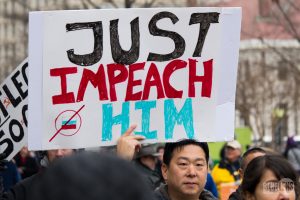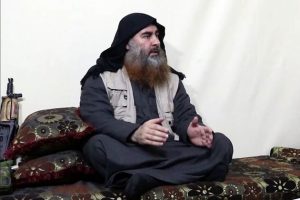by Derek Davison
The Trump administration may be gearing up for another military strike against Syrian President Bashar al-Assad’s military. Late in the day on Monday, the White House released the following statement:
The United States has identified potential preparations for another chemical weapons attack by the Assad regime that would likely result in the mass murder of civilians, including innocent children. The activities are similar to preparations the regime made before its April 4, 2017 chemical weapons attack.
As we have previously stated, the United States is in Syria to eliminate the Islamic of Iraq and Syria. If, however, Mr. Assad conducts another mass murder attack using chemical weapons, he and his military will pay a heavy price.
Nikki Haley, the U.S. ambassador to the United Nations and neoconservative favorite, followed up that statement by tweeting, “Any further attacks done to the people of Syria will be blamed on Assad, but also on Russia & Iran who support him killing his own people.”
The White House hasn’t offered any further comment as to the nature of the alleged “preparations” or how the U.S. “identified” them. On Tuesday, Pentagon spokesman Jeff Davis said that U.S. intelligence had seen activity suggestive of chemical weapons preparations at Syria’s Shayrat airbase over “the past day or two.” But that information doesn’t seem to have been immediately shared with all relevant government agencies.
In fact, Buzzfeed reported just after the statement was issued that “five US defense officials,” including one at US Central Command, the command responsible for Syria, “did not know where the potential chemical attack would come from.” It is certainly out of the ordinary for the White House to issue a statement like this without sharing it across relevant agencies and departments beforehand.
There’s been limited and fairly predictable international response to the statement thus far. British Defense Secretary Sir Michael Fallon told BBC Radio 4’s Today program this morning that “we will support” future U.S. action in response to chemical weapons use in Syria, though he said Washington had not shared its intelligence with the U.K. Kremlin spokesman Dmitry Peskov, meanwhile, said that “such threats to Syria’s legitimate leaders are unacceptable.”
Without more details from the administration it’s hard to know what to make of this statement. Overall, the Trump administration’s approach to the Syrian civil war and to the Assad regime has been disjointed to say the least.
The United States carried out a cruise missile strike against Assad’s Shayrat air base on April 6 in response to an alleged sarin gas against the rebel-held town of Khan Shaykhun two days earlier. Most observers believe that Assad’s air force carried out the attack, though Assad and his Russian allies have consistently denied this. Over the weekend, investigative reporter Seymour Hersh called into question many of the details of the incident.
Prior to the Shayrat strike the Trump administration had been openly pivoting away from the Obama administration’s policy that Assad would have to step down as Syrian president as part of any negotiated settlement to that country’s now six-year-long civil war. And since the Shayrat strike, the administration has not attacked Assad’s military infrastructure again.
However, in recent weeks U.S. forces and their rebel allies have engaged in a number of skirmishes with forces allied with Assad in southern and eastern Syria. American aircraft have twice bombed Assad-supporting militias in southern Syria, on May 18 and June 6. They’ve also twice shot down Iranian-made drones in the same area, on June 8 and June 20. And on June 18, a U.S. fighter shot down a Syrian warplane near the town of Tabqah, just west of Raqqa, the capital of the Islamic State (ISIS or IS)—which is currently under assault by the U.S.-allied Syrian Democratic Forces (SDF). In every case the U.S. has claimed self-defense, despite the questionable legality of its presence in Syria. In the southern Syrian incidents Washington claimed to be defending U.S.-allied rebels and their embedded American advisors at Tanf, while in the Tabqah incident the Syrian plane that was shot down was reportedly bombing SDF positions, or near enough to those positions to be considered a threat.
These incidents have raised concerns that the U.S. is heading toward some kind of confrontation with the Assad regime in southern and eastern Syria. In particular, the Trump administration, which has taken an approach toward Iran that maximizes confrontation at the expense of diplomacy, may view control of eastern Syria as key to preventing Tehran from developing a friendly land corridor through Iraq and Syria all the way to Lebanon, which is a concern for both America and Israel.
What makes Monday’s White House statement more peculiar is that the past few days have seen the U.S. again appearing to take a more relaxed position on Assad. On Friday, a spokesman for the U.S.-led anti-IS coalition said “we absolutely have no problem” with the Syrian army and its allied militias moving into eastern Syria to fight IS, despite those multiple clashes over the past month. And on Monday, U.S. Secretary of State Rex Tillerson and Russian Foreign Minister Sergey Lavrov spoke by phone about ways to reduce the violence in Syria, for example by implementing localized ceasefire agreements. During that call, Lavrov reportedly asked Tillerson to prevent American “provocations” against Syrian forces.
In this context it would make little sense for Assad to invite another U.S. military response like the Shayrat strike. That strike resulted in some of the Trump administration’s most favorable media coverage to date. With the administration still mired in the Russia scandal and Trump’s approval rating threatening to reach new lows, it may be reasonable to ask whether it’s looking for a reason to launch another attack.
Photo: victims of the Khan Shaykhun attack






If I didn’t know better I’d think that Trump had just double-dog-dared the jihadis to stage a fake chemical attack so that he would have a pretext to do embark upon a military strike that he has already decided upon.
But that would be unkind, right?
The author would be advised to refer to Seymour Hersh’s searing investigative exposé in Die Welt of what really happened at Khan Sheikoun, especially as a follow up to the analyses of Dr. Theodore Postol and of former U.S. Intelligence officials, including members of Veterans Intelligence Professionals for Sanity in contact with operatives on the ground, and with Administration officials privy to what really happened.
Hersh’s article puts the full lie to the canard peddled by Trump. which appears motivated by Trump’s Israeli policy- which is to say Israel’s policy- to prevent the SAA’s success on the ground, if not take down Assad.
While Trump claimed to seek better relations with Russia, he has already thrown them under the bus more than once when they delivered what they promised under the deconfliction agreement, and he’s in effect threatening to do so again.
Russiagate was a fabrication to obstruct normalization of relations with Russia and as a pretext for impeaching Trump. IMHO, Trump’s false flag response to Khan Sheikhoun would be proper grounds for impeachment.
As for ‘el Roam’, I’d suggest that 90% of the Syrian people disagree with you and propaganda you are promoting, as do the most respected journalists on the ground in Syria- people like Robert Fisk, Patrick Cockburn, Vanessa Beeley and Eva Bartlett,
What is interestoing about the picture at the top of this article is that it shows “rescue” workers “treating” “victims” without any kind of protective gloves on.
If the “victims” were infected with sarin gas so too would be the “rescuers”.
Such an elementary mistake proves the falsity of the claims of a chemical “attack”.
Edding :
Can you suggest , can you illustrate , even one ( just one ) propagandist item or argument in my comment ?? Reading your comment , how confident you are about this , then surly one may assume , that you would be able , to ” fish ” or pick one at least . Let’ s wait and see ….